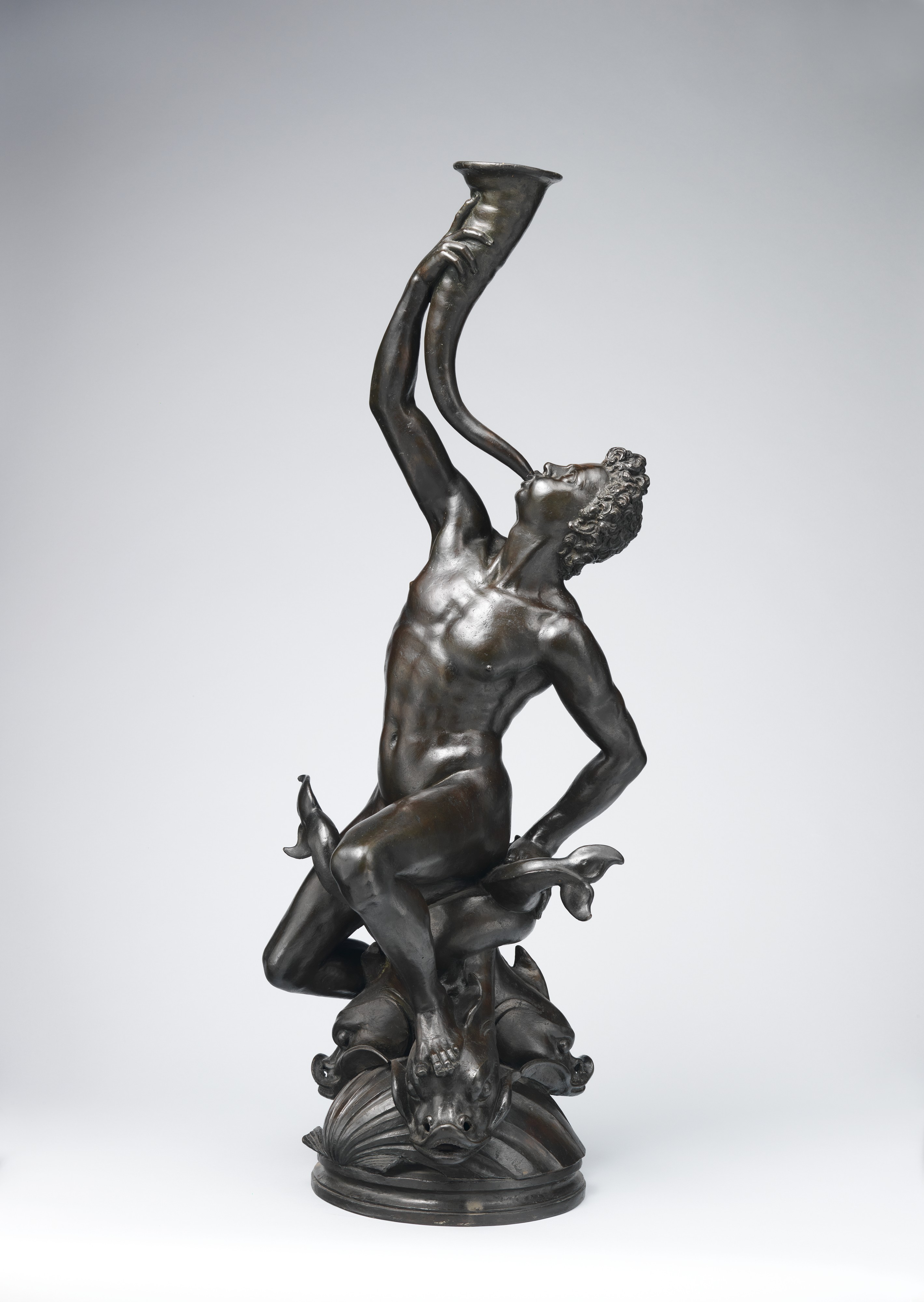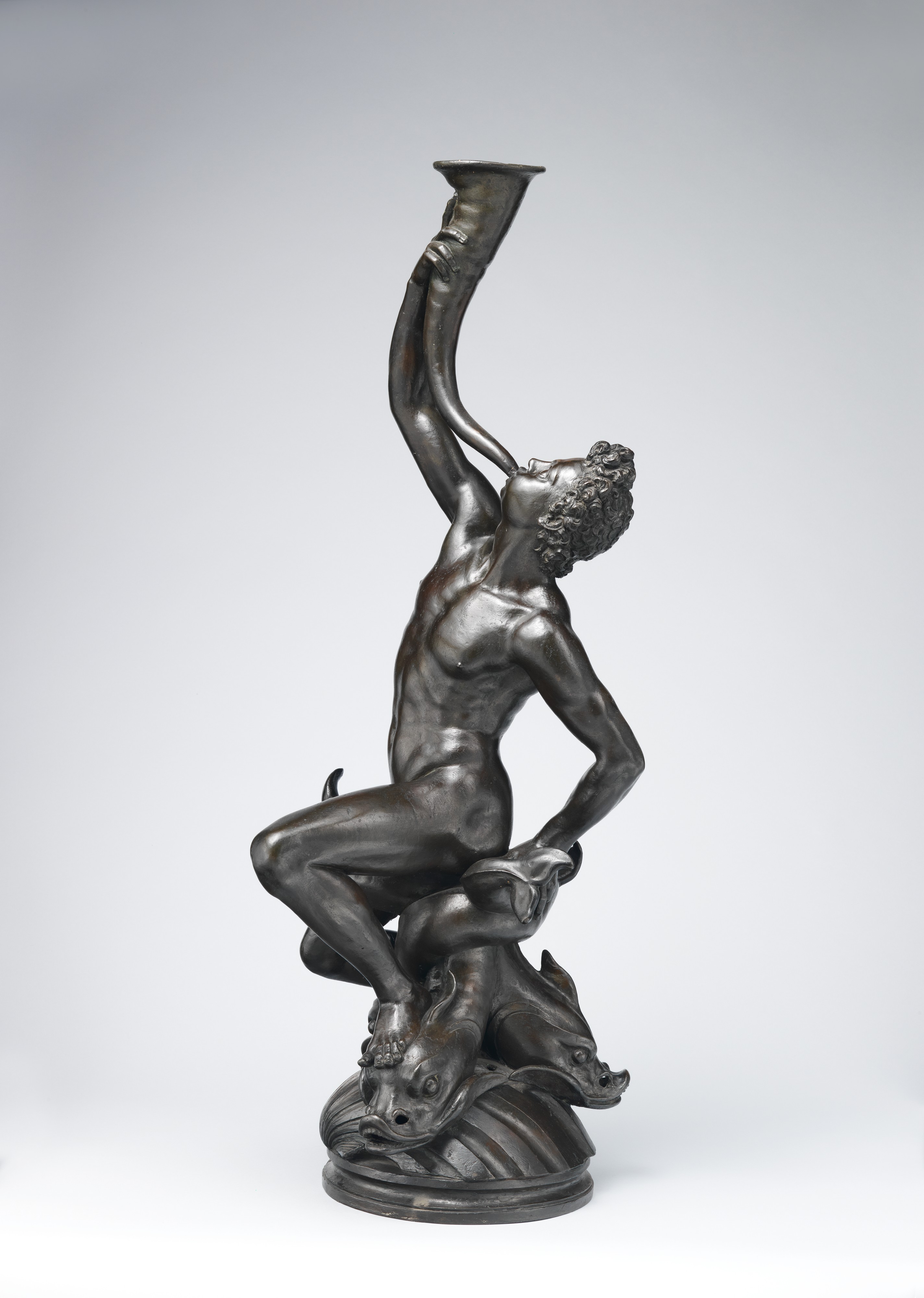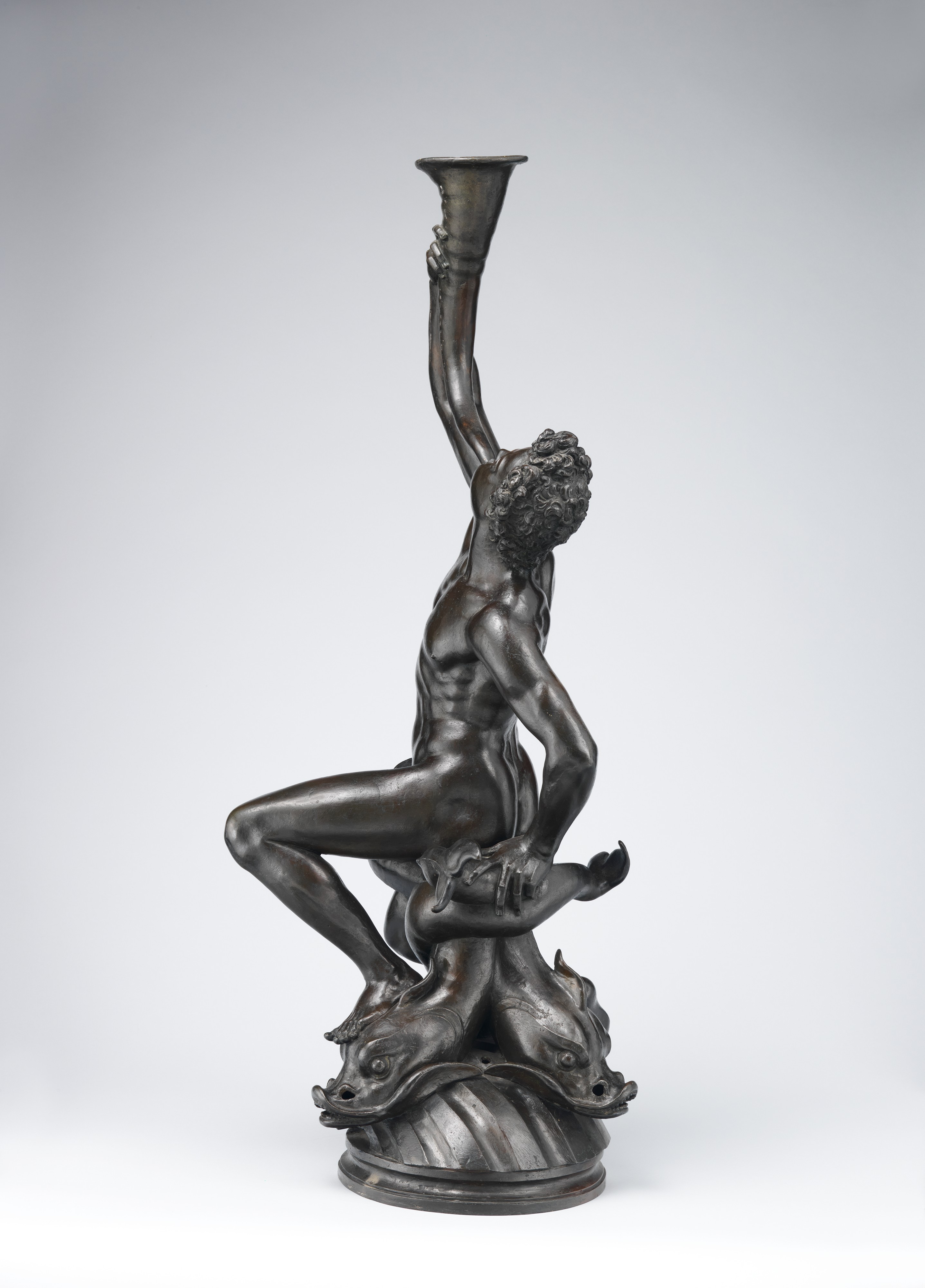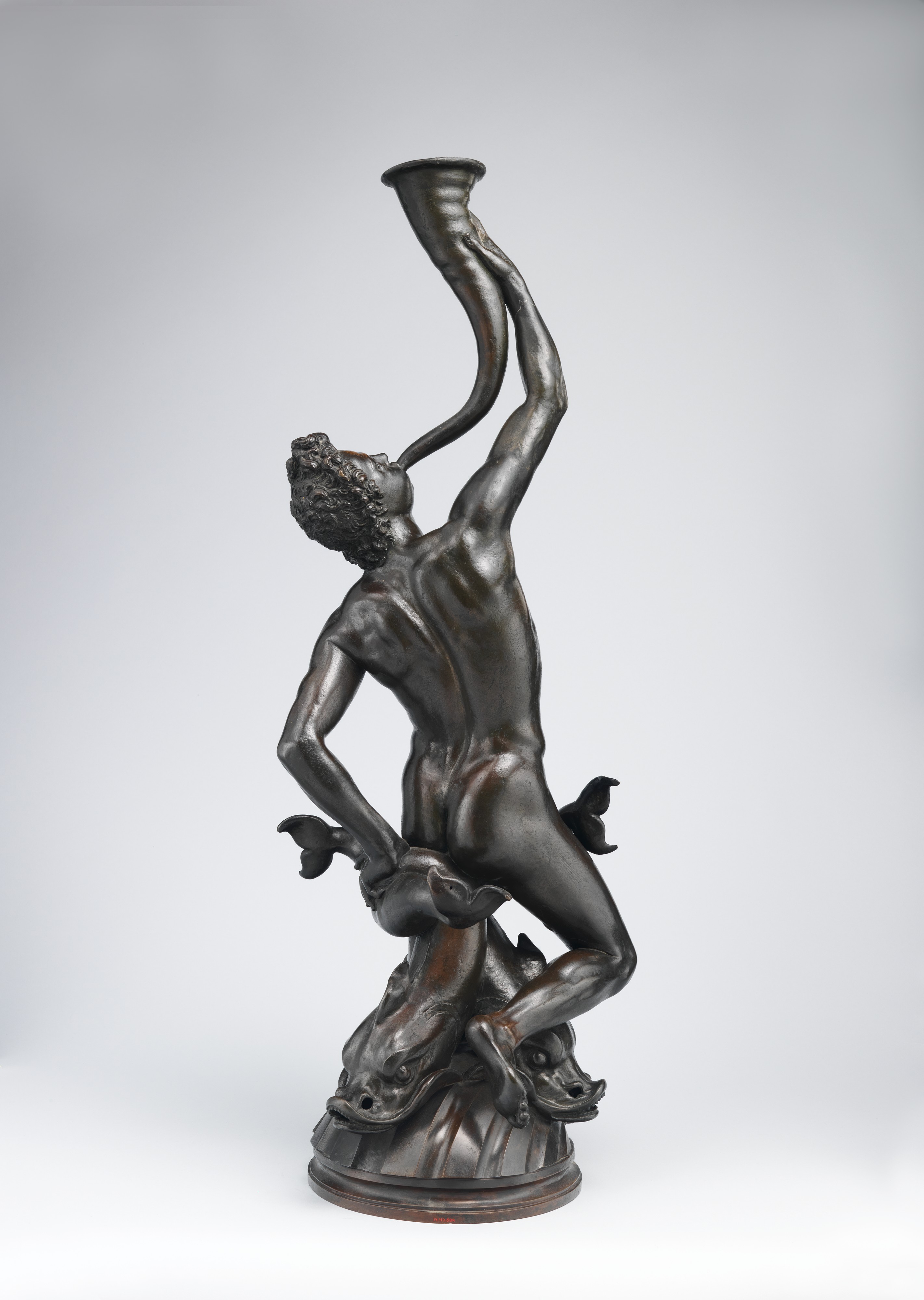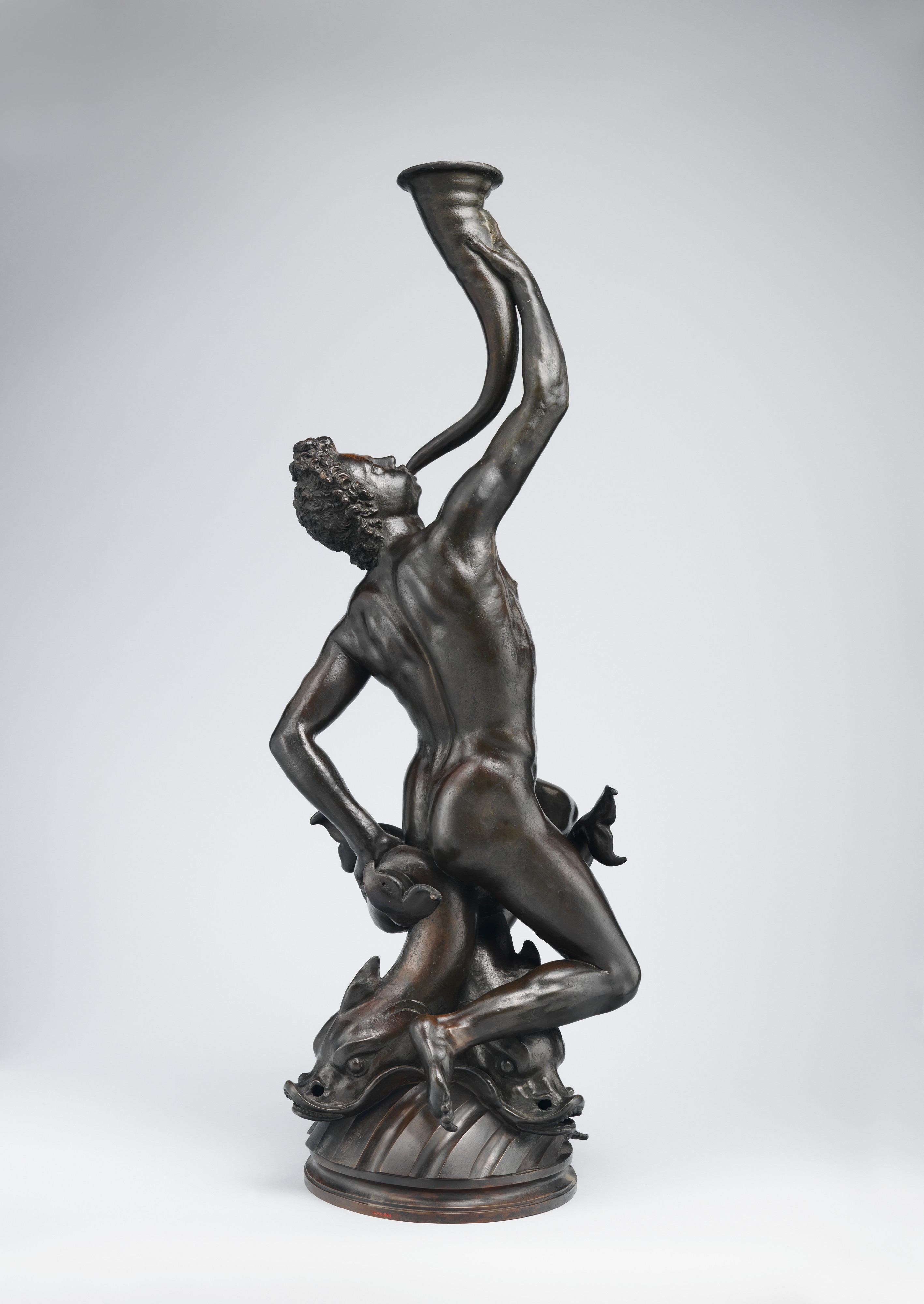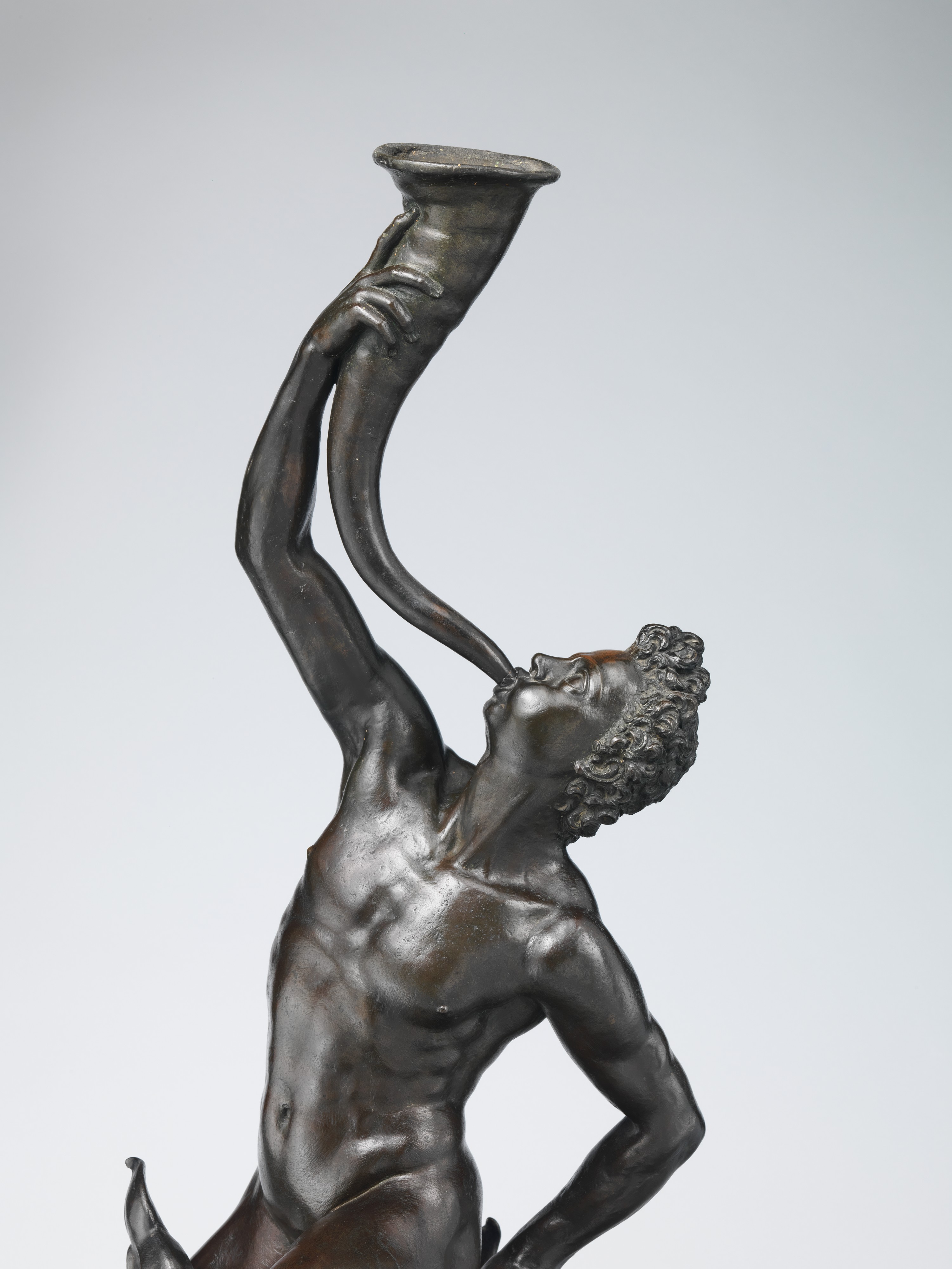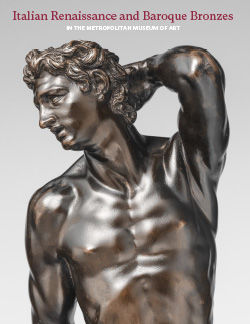Triton
Giambologna Netherlandish
For its superior quality, scale, and historical significance, this statue of a sea deity holds a preeminent position in The Met’s collection of bronzes. It originally surmounted a freestanding fountain (now lost). Limbs akimbo, the Triton grasps a dolphin’s tail behind him for purchase, thrusts out his chest, and puffs his cheeks to blow into an elongated, shell-like horn held straight above his upturned head. Water bursting from the horn would have cascaded over the figure and splashed into the basin below with a pleasing rush of sound and shimmers of light. Conceived to be viewed from all angles, the figure’s implied rotation is amplified by limbs that extend outward in every direction like fans on a pinwheel. Repetitions in the design reinforce its in-the-round character: the Triton perches on a circular base formed of three dolphins with interlacing tails and heads resting on three inverted scallop shells. The pictorial quality of the modeling and the dazzling anatomy of the lithe, supple body bespeak a substantial creative investment. In the extraordinary head of hair, one can sense the fastidious rendering of each lock and curl done in the wax.
The statue’s attribution to Giambologna is now well established, and in all probability it can be identified as one of several bronzes by the sculptor that Ferdinando I de’ Medici gifted to Henry IV of France in 1598. Four smaller variants are known: in the Frick,[1] the Kunsthistorisches Museum,[2] and the Louvre;[3] and one formerly in the Cyril Humphris collection.[4] The Met’s statue, the largest of the group, is undoubtedly the most complex, and there are subtle differences among the variants, factors that were carefully weighed when attempting to identify the Triton’s prototype—the invenzione—and its creator.[5]
The fortuna critica of the Triton is inextricably linked to a large marble in Palermo (Museo Archeologico Regionale Antonino Salinas) usually assigned to Battista Lorenzi, but recently revealed as a copy of Lorenzi’s original, which was shipped to Madrid in the 1640s and is now lost.[6] The bronze entered The Met in 1913 as part of the bequest of Benjamin Altman. It was initially attributed to Giambologna’s prolific student Adriaen de Vries. Erich von Strohmer agreed and placed it at the end of the 1620s due to its similarity to de Vries’s Tritons on the Fountain of Neptune in the Schloss Frederiksborg, Drottningholm, dated 1617. Lars Larsson, in his monograph on de Vries, rejected the attribution. Hans Weihrauch was the first to propose the name of Battista Lorenzi for our bronze, on the basis of his marble Triton in Palermo. John Pope-Hennessy agreed, with the caveat “inspired by Giovanni Bologna.” Manfred Leithe-Jasper, also noting our statue’s closeness to Giambologna’s style, accepted the attribution to Lorenzi and suggested it was the model for the smaller bronzes.[7]
Meanwhile, in his doctoral dissertation of 1959, James Holderbaum had included the bronze in Giambologna’s oeuvre.[8] Twenty years later, the master’s paternity was bolstered by Herbert Keutner, who considered the Altman Triton an autograph work from the late 1590s (although based on a 1560s model), given the formal affinities with the artist’s Angel for the Duomo in Pisa and the Flying Mercury in the Louvre, “works which are comparable in their relatively summary modelling and chasing and in which the collaboration of Pietro Francavilla and Pietro Tacca has to be allowed for.”[9] Keutner’s analysis is based on a 1598 inventory of Ferdinando I de’ Medici’s collection that mentions “items that His Highness sent to France . . . [including] a triton with dolphins that spurts water, from the hand of Gian Bologna. Pounds 110 [about 37 kilos].”[10] James David Draper argued that the Altman Triton is “another case of an early masterpiece” by Giambologna, “perhaps as early as 1562,” associating it with his Samson (V&A) and Florence Triumphant over Pisa (Bargello).[11] In light of these developments, Leithe-Jasper shifted his attribution from Lorenzi to Giambologna.[12] Finally, Charles Avery supported Giambologna’s authorship in his 1987 monograph on the artist.[13] Notwithstanding disagreements over dating and the more or less strong contribution of the workshop, the assignment to Giambologna now appears settled.[14]
Provenance remains an open question, however. Confirmation that our Triton is indeed the bronze delivered to France by Ferdinando I before 1598, as Keutner believed, would of course solidify its dating. The bronzes were escorted to Paris by the goldsmith Jacques Bylivelt and the composer Emilio de’ Cavalieri, superintendent of the Guardaroba Medicea.[15] As corroborated in documents published by Blanca Truyols, the sculptures were installed in the gardens of Saint-Germain-en-Laye at the behest of Henry IV. Truyols also stressed the significance of the Triton’s presence on a list of bronzes, including a Mercury, cast by Domenico Portigiani for Giambologna and sent to France (“In France a figure of 3 braccia to Sig. Girolamo Gondi, and two of 2 braccia for the King’s garden, and a Mercury and Triton”).[16]
Alexander Rudigier proposed that a sketchy seated figure blowing a horn visible in Abraham Bosse’s 1624 print depicting the so-called Grotto of the Lady Who Plays the Organ in the gardens of Saint-Germain-en-Laye might be the Altman Triton (fig. 116a).[17] The statue’s location in a niche, per the engraving, would not have favored an in-the-round statue, but its scale—medium-sized, like ours—supports the identification.[18] Further evidence of the Triton’s presence in the grotto is provided in André Duchesne’s description from 1609. Recall that a large bronze Mercury was sent to France along with a Triton. Based on Giambologna’s more famous rendition today in the Bargello, the Mercury was cast for Ferdinando when he was still a cardinal in Rome.[19] According to Duchesne, in the grotto was “a Mercury near the window, which has one foot up in the air and the other [foot] planted on a support, loudly sounding a trumpet.”[20] Clearly, Duchesne conflated the two bronzes, as the first half of the description corresponds to the Mercury and the second half to the Triton.
Though there is a marked discrepancy between the current weight of our bronze (53.9 pounds) and that of the one sent to Henry IV noted in the 1598 document (110 pounds), a number of factors might account for this, which on its own cannot be considered a binding reason for accepting or rejecting the identification. Rudigier and Truyols provide a plausible explanation: the statue would likely have been fitted with a lead hydraulic mechanism before its transport to France.[21] Many other factors have no doubt altered the weight of the Triton through the centuries. Recent technical analysis carried out by Richard Stone revealed a thick-walled cast with a continuous layer of copper corrosion on the surface—largely explained by the Triton’s function as a fountain.[22]
All of these factors lead to the conclusion that the Altman Triton and the Giambologna bronze that Ferdinando I presented to Henry IV are one and the same.[23]
How and when Giambologna arrived at the original invenzione, whose influence can be seen in Bernini’s Triton and beyond, is another point of contention. Keutner located the original model for the bronzes in the Triumph of Neptune relief on the Fountain of the Ocean in the Boboli Gardens.[24] The fountain is a mature masterpiece by Giambologna whose figures were sculpted between 1571 and 1576.[25] Does this detail help us in dating the Altman Triton? If we subscribe to the supposition that Lorenzi’s Triton in Palermo was inspired by Giambologna, we must then date his invenzione before 1577, when Lorenzi’s work was documented in Sicily.[26] On the other hand, Giambologna’s prototype may not be the Altman Triton. Instead, our bronze could be based on a previous model by the master that he revisited in the 1590s. This is supported by technical characteristics that indicate the Altman bronze is an indirect cast, pointing to the existence of a preserved model.[27] In this regard, Truyols claimed that an earlier version of our Triton had been cast for Emilio de’ Cavalieri, probably in 1591.[28] Truyols’s theory is based on two pieces of documentation. The first records a payment to Portigiani for casting an unspecified bronze figure for Cavalieri in 1591.[29] The second, a letter of July 3, 1599, from Francesco Bonciani, Ferdinando I’s agent in Paris, reports the French king’s satisfaction with the gift of bronzes, adding: “Let me also tell your Lordship that, for a fountain [Tommaso] Francino would like to do, it would be perfect [to have] a Triton that spurts water upward similar to the one of Signor Emilio dei Cavalieri, which was sent here for the King.”[30] Bonciani is clearly requesting a pendant to the Triton already in France, but Truyols misreads this sentence as a reference to another cast of the Triton ostensibly made for Cavalieri before he delivered the one gifted to Henry IV, and mistakenly concluded that Portigiani cast two Triton bronzes in the 1590s. It is not by chance that Portigiani, in his list of bronzes cast for Giambologna, mentions only one Triton, that sent to France.[31]
On a second level of analysis, does Bonciani’s letter tell us that the Triton presented to Henry IV was previously in the possession of and/or commissioned by Cavalieri? It’s a possibility. This opens up an exciting avenue of investigation: the connection between the Triton and the world of music, which might corroborate an intuition that Michael Cole had well before a possible link between Cavalieri and the bronze surfaced. Cole argued that “a catalogue of Giambologna’s exhaling sculptures would have to include his Bagpiper [the Altman Triton], which not only fills a container with breath, but connects that breath to a notional tune. It would also have to note that Giambologna was one of many sculptors to turn his exhalation into music, materializing in water the sonorous waves of a wind instrument.”[32] What if Giambologna created the Triton under the intellectual stimulus of the influential Florentine musician? Cavalieri may well be the key figure in this story. All signs point to the Triton retaining such musical connotations in its translation to a French context. The Grotto of the Lady Who Plays the Organ, if that was indeed the Triton’s landing place, was a recreational space obviously linked to music, but also an environment in which the relationship between sound and water was celebrated and performatively explored, as is made evident in Duchesne’s description of the grotto.
Returning to the question of the invenzione: Giambologna likely formulated his design for a freestanding male figure blowing a horn in the late 1560s or early 1570s, the years in which he worked on the Fountain of the Ocean. This dating is compatible with the chronology of several other Florentine statues with the same musical characteristics sculpted in the 1570s: Battista Lorenzi’s marble Triton (before 1577); the marble Misenus and the now-lost stone Triton carved by Stoldo Lorenzi for the Villa Corsi (1571–73); and a lost marble Mercury by Vincenzo de’ Rossi.[33] We do not know the nature, materiality, and use of this hypothetical first model created by Giambologna, but it might have been instrumental in the making of the Altman Triton, whose casting can be reasonably dated to the 1590s.
In regard to the invenzione, the relationship between our Triton and a drawing in the Cooper-Hewitt National Design Museum, New York, should be clarified.[34] Attributed to an anonymous seventeenth-century Flemish artist, the drawing depicts a Triton very similar to ours and the one in Palermo, surmounted on a basin identical to the figure designed by Giambologna for his Fountain of Samson and a Philistine. More recent investigations reveal that the Cooper-Hewitt sheet is not a design by Giambologna, but rather depicts a fountain in the Jardín de la Reina in the Buen Retiro, Madrid, that was created by assembling Lorenzi’s marble Triton (transported from Palermo) and the original basin of Giambologna’s Samson fountain.[35] The drawing thus does not provide any useful information for the history of the Altman Triton’s conception.
Giambologna’s composition remained popular well into the modern era. During the eighteenth century, the model was studied in England with the same reverence accorded an ancient sculpture. A drawing by Edward Francis Burney shows the Triton at the rear of a classroom set on a pedestal inside a large niche (fig. 116b). It corresponds to the Altman Triton in its features, scale, and even the shell-shaped base, and may very well illustrate a plaster copy of it. We do not know how or where the Royal Academy would have acquired such a copy (it would be a stretch to think that the bronze was ever in England), but the work was deemed essential to education in the British Academy. A modern reproduction was displayed at the 1867 Exposition Universelle in Paris, a testament to the enduring fame of Giambologna’s invenzione. The exhibition catalogue illustrates it with the caption, “This fine statuette and pedestal, in bronze, are contributed by De Amici Angelo, the work of the sculptor Franzosi Giuseppe, both in Milan” (fig. 116c). This Milanese reproduction looks very much like the Frick variant, suggesting that the latter is indeed a late nineteenth-century cast.
-FL
Footnotes
(For key to shortened references see bibliography in Allen, Italian Renaissance and Baroque Bronzes in The Metropolitan Museum of Art. NY: The Metropolitan Museum of Art, 2022.)
1. The very nimble Frick Triton (1916.2.44; 44.1 cm) entered the literature thanks to Wilhelm von Bode (1907–12, vol. 2, pl. CXLIX; and 1910, vol. 1, pp. xxviii–xxix, vol. 2, p. 5, no. 121, fig. LXXXIV) with an unpromising attribution to Cellini. Wiles 1933, p. 89, cited Bode’s opinion but pointed up affinities with Giambologna’s Mercury and Samson. Weihrauch 1967, p. 188, with little reasoning, named Battista Lorenzi, accepted by Pope-Hennessy 1970, pp. 203–6, even though the latter acknowledged significant differences in finish and details and concludes that The Met and Frick pieces could “hardly have been produced in the same studio.” Lastly, Keutner (in C. Avery and Radcliffe 1978, p. 92, cat. 41) linked everything back to Giambologna but, leery of a full attribution, considered the Frick bronze to be a “later cast.”
2. Wiles 1933, pp. 88–89, brought the Vienna Triton (KK 9115; 44.8 cm) closer to Giambologna. Leithe-Jasper (in Tokyo 1973, cat. 90, and Feuchtmüller 1976, pp. 88–89, cat. 88) assigned it to Battista Lorenzi, in accord with Weilhrauch 1967, p. 188. Keutner (in C. Avery and Radcliffe 1978, p. 92, no. 41) thought it “Possibly a cast by Pietro Tacca.” Leithe-Jasper 1986, pp. 220–22, cat. 56, embraced Keutner’s theory with an attribution “after Giambologna.”
3. Wiles 1933, pp. 88–89, 131, tentatively put forward Giambologna’s name for the Louvre Triton (TH 95; 42.5 cm), together with the Frick and Vienna statuettes. Following Weihrauch 1967, p. 188 (who, however, had not explicitly cited the Louvre Triton), Jestaz 1969, p. 81, labeled it “d’après Battista Lorenzi ?,” considering it closer to the manner of Giambologna. Keutner (in C. Avery and Radcliffe 1978, pp. 91–92, no. 41) was committed to the Louvre Triton as a Giambologna invention, with which Jestaz 1979, p. 78, immediately agreed. Jestaz also noted the existence of a silver Triton in the collection of Louis XIV (“Une figure de jeune homme qui joue du corps assis sur un grouppe de trois dauphins, un ligne et un corps d’argent vermeil doré d’Allemagne, haut de 18 pouces”; cited in Guiffrey 1885–86, vol. 1, p. 62, no. 426).
4. “A rare bronze figure of a Triton blowing a horn. Early 17th Century, after a model by Giambologna” (42 cm), Sotheby’s, New York, January 10–11, 1995, lot 216; see also Schallert 2001, p. 514 n. 6.
5. As if playing the game Spot the Difference, we find that in fact none of the small bronzes corresponds perfectly to the Altman Triton. Apart from the inevitable deviations that occur during casting, the chief variables are, first, the position of the legs: bent and spread apart in the Louvre and Frick bronzes; in the others, the left leg bent and the other lowered, almost kneeling. Second, the horn: a thin aperture in the Louvre, Vienna, and Frick casts; a wide trumpetlike blowhole on the Altman statue. Finally, on the Vienna statuette, the left arm does not rest on the rock base but extends away from the body and holds in the hand a pierced half-shell, which one infers was designed as a nozzle.
6. For the Lorenzi attribution, see Borghini 1584, p. 598; Wiles 1933, pp. 88–89, 131, 137–38. For the fate of Lorenzi’s original marble, see Loffredo 2012, pp. 84–86.
7. Altman 1914, p. 132, no. 72; Strohmer 1947–48, p. 120; Larsson 1967, p. 127, no. 26; Weihrauch 1967, p. 188; Pope-Hennessy 1970, pp. 203–6; Leithe-Jasper in Tokyo 1973, cat. 90, and Feuchtmüller 1976, pp. 88–89, cat. 88 (both on the Vienna Triton).
8. Holderbaum 1983, pp. 112, 334, fig. 103.
9. Keutner in C. Avery and Radcliffe 1978, pp. 92–93, cat. 41 (on the Louvre Triton).
10. “Copia di un inventario di robe che Sua Altezza à mandato in Francia . . . un tritone con dalfini che getta aqua di mano di gian bologna. libbre 110” (Keutner in C. Avery and Radcliffe 1978, p. 91). The inventory is published in full in Barocchi and Bertelà 2002–11, vol. 2.2, pp. 527–29. A new transcription is provided in Rudigier and Truyols 2016, pp. 268–69, and, with several corrections, in Lurin 2018, pp. 123–24.
11. Draper 1978b.
12. Leithe-Jasper 1986, p. 220, cat. 56.
13. C. Avery 1987, p. 210; see also C. Avery 2006, p. 145.
14. For more recent scholarship, see Negri Arnoldi 1997, pp. 292–93; Schallert 2001; Cole 2003, pp. 144–45; Loffredo 2012, pp. 60, 97 n. 8; Rudigier and Truyols 2016, pp. 255–56, 263, 293–96.
15. Rudigier and Truyols 2016, pp. 251–85. On Emilio de’ Cavalieri, see Kirkendale 2001.
16. This list is an undated autograph document, written by Domenico Portigiani most probably between the end of 1600 and the beginning of 1601, listing the bronzes cast for Giambologna and their whereabouts: “In Francia, una figura di 3 braccia al sig. Girolamo Gondi, et 2 di braccia 2 per il giardino del Re, et un Mercurio et Tritone.” Rudigier and Truyols 2016, p. 266. The list was first published in Francqueville 1968, pp. 149–50.
17. Rudigier and Truyols 2016, pp. 293–94; followed by Lurin 2018, p. 117. The caption on the bottom of the print reads: “Cecy est la Grotte de la Damoiselle qui Joue des Orgues laquelle Grotte est en une des teste de la Galerie de la Première terrasse du Châ[tea]u de S[aint] Germain en Laye au lieu Marqué E au portrait de S[aint] Germain. T[ommaso] de Francini inven[it], A[braham] Bosse sculp[sit] 1624.”
18. This issue is noted by Rudigier and Truyols 2016, p. 294.
19. On the contested claim that the Mercury sent to Henry IV is the Louvre’s Flying Mercury, see Rudigier and Truyols 2016, pp. 289–93. For an opposing (and more convincing) argument, see Bresc-Bautier 2018.
20. Duchesne 1609, p. 277: “Il y a un Mercure près la fenestre, qui a un pied en l’air, & l’autre planté sur un apuy, sonnant & entonnant hautement une Trompette.” Ernstinger 1877, pp. 226–27, in his description of Saint-Germain-en-Laye, mentions only a “bronze statue of a Mercury on a column.”
21. Rudigier and Truyols 2016, pp. 263 n. 14, 294.
22. R. Stone/TR, April 15, 2011.
23. Rudigier assumes that Count Esterházy, Austrian envoy to Paris, purchased the bronze there. Rudigier and Truyols 2016, p. 294.
24. Specifically, two figures seen from the back; see Keutner in C. Avery and Radcliffe 1978, pp. 91–92, cat. 41.
25. For the chronology of the Fountain of the Ocean, see Laschke 2000, pp. 70–74; Morét 2003, pp. 262–72; and the documentation in Paolozzi Strozzi and Zikos 2006, pp. 246–48, cat. 48. Rudigier and Truyols 2016, p. 347 n. 29, attribute the reliefs to Hans Mont, who collaborated with Giambologna, offering no stylistic or documentary justification.
26. See Loffredo 2012, p. 57.
27. Conversations with conservators Richard Stone and Linda Borsch.
28. Rudigier and Truyols 2016, pp. 255–56, 294.
29. Ibid., pp. 263 n. 13: “per havere ricotto et gittato una forma d’una figura al sig. Emilio Cavalieri.”
30. “né lascerò di dire a V. S. che per una fontana che li vorrebbe fare [Tommaso] Francino, sarebbe molto a proposito un Tritone che gittasse l’acqua in alto simile a quella del s.r Emilio dei Cavalieri venuto qua per il Re.” Rudigier and Truyols 2016, pp. 275–76.
31. In ibid., p. 282 n. 3, Truyols chalks up this absence to an incomplete list.
32. Cole 2003, p. 144.
33. On the origins and popularity of the subject of a male figure playing a horn, see Loffredo 2012, pp. 60–61.
34. Cooper-Hewitt, 1911-28-459; published in Wiles 1935, pp. 31–32, and Maser 1957, p. 23 n. 27, as by “Artist unknown, Netherlands, about 1650–1675.”
35. Loffredo 2012, p. 85. Another drawing of the same fountain can be found in the diplomatic diary of the admiral Edward Montagu, first earl of Sandwich, who in 1666 was sent to Spain by Charles II; see ibid., pp. 62–65. On Montagu at the Buen Retiro, see also J. Brown and Elliott 2003, p. 78, fig. 48.
Due to rights restrictions, this image cannot be enlarged, viewed at full screen, or downloaded.
This artwork is meant to be viewed from right to left. Scroll left to view more.


